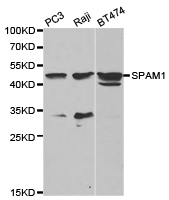Hyaluronidase PH20 (SPAM1) Rabbit Polyclonal Antibody
Frequently bought together (3)
Recombinant protein of human sperm adhesion molecule 1 (PH-20 hyaluronidase, zona pellucida binding) (SPAM1), transcript variant 1
USD 439.00
Transient overexpression lysate of sperm adhesion molecule 1 (PH-20 hyaluronidase, zona pellucida binding) (SPAM1), transcript variant 1
USD 396.00
Other products for "SPAM1"
Specifications
| Product Data | |
| Applications | ICC/IF, IHC, WB |
| Recommended Dilution | WB 1:500 - 1:2000;IHC 1:50- 1:200;IF 1:50- 1:200 |
| Reactivities | Human, Mouse, Rat |
| Host | Rabbit |
| Isotype | IgG |
| Clonality | Polyclonal |
| Immunogen | Recombinant protein of human SPAM1 |
| Formulation | Store at -20C or -80C. Avoid freeze / thaw cycles. Buffer: PBS with 0.02% sodium azide, 50% glycerol, pH7.3 |
| Concentration | lot specific |
| Purification | Affinity purification |
| Conjugation | Unconjugated |
| Storage | Store at -20°C as received. |
| Stability | Stable for 12 months from date of receipt. |
| Gene Name | sperm adhesion molecule 1 |
| Database Link | |
| Background | Hyaluronidase degrades hyaluronic acid, a major structural proteoglycan found in extracellular matrices and basement membranes. Six members of the hyaluronidase family are clustered into two tightly linked groups on chromosome 3p21.3 and 7q31.3. This gene was previously referred to as HYAL1 and HYA1 and has since been assigned the official symbol SPAM1; another family member on chromosome 3p21.3 has been assigned HYAL1. This gene encodes a GPI-anchored enzyme located on the human sperm surface and inner acrosomal membrane. This multifunctional protein is a hyaluronidase that enables sperm to penetrate through the hyaluronic acid-rich cumulus cell layer surrounding the oocyte, a receptor that plays a role in hyaluronic acid induced cell signaling, and a receptor that is involved in sperm-zona pellucida adhesion. Abnormal expression of this gene in tumors has implicated this protein in degradation of basement membranes leading to tumor invasion and metastasis. Multiple transcript variants encoding different isoforms have been found for this gene. |
| Synonyms | HEL-S-96n; HYA1; HYAL1; HYAL3; HYAL5; PH-20; PH20; SPAG15 |
| Reference Data | |
| Protein Families | Druggable Genome, Transmembrane |
| Protein Pathways | Glycosaminoglycan degradation, Metabolic pathways |
Documents
| Product Manuals |
| FAQs |
| SDS |
{0} Product Review(s)
0 Product Review(s)
Submit review
Be the first one to submit a review
Product Citations
*Delivery time may vary from web posted schedule. Occasional delays may occur due to unforeseen
complexities in the preparation of your product. International customers may expect an additional 1-2 weeks
in shipping.






























































































































































































































































 Germany
Germany
 Japan
Japan
 United Kingdom
United Kingdom
 China
China




